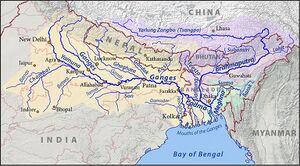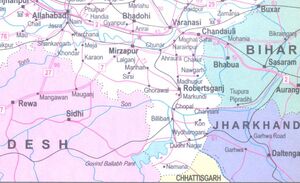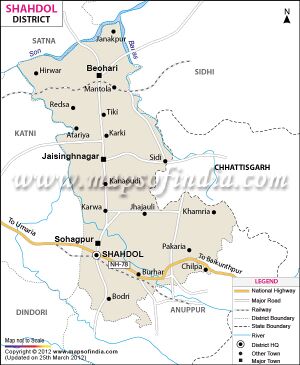Sone
| Author:Laxman Burdak, IFS (R) |


Son River (सोन नदी) of central India is the largest of the Ganges' southern tributaries. Bansagar (बाणसागर) is a multipurpose river Valley Project on Sone River situated in the Ganges Basin in Madhya Pradesh, India. [1]
Variants of name
- Shona शोण = Mahashona महाशोणा = Hiranyavaha हिरण्यवाह (AS, p.911)
- Hiranyavaha हिरण्यवाह (AS, p.1025)
- Iranobaos (इरानोबाओस) = Hiranyavaha (हिरण्यवाह) (AS, p.912)
- Shona/Shona River (शॊण) Mahabharata (III.83.9), (VI.10.28), Ramayana (4-40-21)
- Sona (सोन)
- Son River (सोन नदी)
- Sone River (सोन नदी)
- Mahashona (महाशोण)=Sone (सोन) (AS, p.176)
- Mahashona (महाशोण) = महाशोणा = Shona शोण (AS, p.726)
- Magadhi मागधी = Sone River सोन नदी (AS, p.732)
- Shonabhadra शोणभद्र (AS, p.912)
- Erannoboas (Pliny.vi.22) The name was probably derived from the Sanskrit Hyranyavahas, the poetical name of the Sonus.
- Sonus (Pliny.vi.22)
Origin
The Son originates near Amarkantak in Madhya Pradesh, just east of the headwater of the Narmada River.
Course

The Sone originates near Amarkantak in Anuppur district of Madhya Pradesh,[2] just east of the headwater of the Narmada River, and flows north-northwest through Shahdol district in Madhya Pradesh state before turning sharply eastward where it encounters the southwest-northeast-Kaimur Range. The Sone parallels the Kaimur hills, flowing east-northeast through Uttar Pradesh, Jharkhand and Bihar states to join the Ganges just west of Patna. Geologically, the lower valley of the Son is an extension of the Narmada Valley, and the Kaimur Range an extension of the Vindhya Range.
Anuppur, Chopan, Deori, Rohtasgarh, Dehri, Sonbhadra and Bihta are the major cities situated on Sone River.
Its chief tributaries are the Rihand, Banas, Kanhar and the North Koel.
Places on Sone River
Kumhari (R) → Manura (R) Dandiya (L) Karhani (L) merges with Kevai from right near Barbaspur → Kusmahai (L) → Rahilakachar (R) → Keyotar (L) + Dhurwasin (R) → Mauhari (L) → Barri (L) → Bhagat Bandh (R) → Harri (L) → Crosses Kotma Rd → Chachai Viran (L) → Chachai Lake (L) → Kelhauri (L) → Sone River Dam → Amlai (L) → Chaura Mata Bakhi (L) → Chaka (R) → Jarwahi (L) → Sonvarsha (L) → Hadh → Sone River Bridge → Bhaga (R) → Khetauli (L) → Gudha (R) → Kanwahi (R) → Shyamdih NO.1 → River from Right → Kushhai (L) → Son Tola (R) → Rohaniya (L) → Karri (R) → Tikuri (L) → Naugai (L) → Godaru (R) → Madhi (L) → Belaha (R) → Sitamadhi Waterfall → Palli (L) → Kichkhidi (L) → Badwahi (L) → Kelhari (L) → Sone Johila Sangam (Johila from left)) → Sone River Bridge → Bhamraha (L) → Badar (L) → Hardua (R) → Masira (R) → Gavarde (L) → Baigaon (L) → Harchauta (L) → Pasondih (R) → Kila Dongari (L) → Karpa (R) → Hartala (R) → Amiliya (L) → Sone River Bridge () → Hardi (L) → Jhal (L) submergens area → Surtan (L) → Sone River Railway Bridge → Bholgarh (L) → Indwar (L) → Dhanwahi (L) → Itma (L) → Padhkhuri (L) →
Koyal River
Koyal River or Koyal/Koyala (कोयल) (AS, p.236) is a tributary of Sone River.[3]
History
The Sheshnaga rulers who earlier had their capital at Rajgir, shifted to Patliputra on the confluence of Rivers Ganga and Sone. The ambitions Nanda killed their last ruler and annexed the State. Nanda also conquered the Kaushal kingdom.
Mention by Pliny
Pliny[4] mentions ' The Ganges.'....Some writers have stated that this river, like the Nile, takes its rise from unknown sources,1 and, in a similar manner, waters the neighbouring territory; others, again, say that it rises in the mountains of Scythia. They state also that nineteen rivers discharge their waters into it; those among them that are navigable, besides the rivers already mentioned,2 are the Condochates,3 the Erannoboas,4 the Cosoagus,5 and the Sonus.
1 So much so, indeed, that its sources were unknown to the learned world till the beginning of the present century, although the Chinese emperor Tang-Hi on one occasion sent a body of Llamas for the purpose of inquiring into the subject. It is now ascertained that the river Ganges is the result of the confluence of three separate streams, which bear the respective names of the Gannavi, the Bhagirathi, and the Alakananda. The second is of the most sacred character, and is the one to which the largest concourse of pilgrims resort. The ancients held various opinions as to the sources of the river.
2 The Cainas and the Jomanes, mentioned in the last Chapter.
3 The modern Gandaki or Gundûk is generally supposed to be represented by the Condochates.
4 Represented as flowing into the Ganges at Palimbothra, the modern Patna. There has been considerable discussion among the learned as to what river is indicated by this name. It has, however, been considered most probable that it is the same as the Sonus of Pliny, the modern Soane, though both that author, as well as Arrian, speaks of two rivers, which they call respectively Erannoboas and Sonus. The name was probably derived from the Sanscrit Hyranyavahas, the poetical name of the Sonus.
5 Supposed to be the same as the river Cosi or Coravaha.
अंध नदी
विजयेन्द्र कुमार माथुर[5] ने लेख किया है ...अंध (AS, p.5) श्रीमद्भागवत में उल्लिखित एक नदी.... 'नर्मदा चर्मणवती सिंधुरन्ध्रशोणश्च' (5,19,18). सिंधु, यमुना की सहायक सिंध है और शोण वर्तमान सोन. इन्हीं के समीप बहने वाली किसी नदी का नाम अंध हो सकता है. संभव है, यह वर्तमान केन या शुक्तिमती ही का नाम हो. इसका संबंध अंधक से भी हो सकता है जो श्री डे के अनुसार भागलपुर के निकट गंगा में गिरने वाली चंदन नदी है.
शोण नदी = महाशोणा = हिरण्यवाह
शोण = महाशोणा = हिरण्यवाह (AS, p.911): विजयेन्द्र कुमार माथुर [6] ने लेख किया है ... शोण नदी वर्तमान सोन नदी, जो पटना (बिहार) के निकट गंगा में मिलती है। यह नदी नर्मदा के उद्गम से चार-पांच मील दूर गोंडवाना पर्वत श्रेणी (शोणभद्र) से निकलती है और प्रायः 600 मील का मार्ग तय करके गंगा में गिर जाती है। इस नदी को महाशोणा तथा हिरण्यवाह भी कहा गया है। महाकवि बाणभट्ट ने हर्षचरित (प्रथम उच्छ्वास) में अपना जन्म स्थान शोण तथा गंगा के संगम के निकट प्रीतिकूट नामक ग्राम बताया गया है। अपनी पूर्वजा पौराणिक देवी सरस्वती के मृत्युलोक में अवतीर्ण होने के स्थान को शोण के निकट वर्णित करते हुए बाण ने शोण को दंडकारण्य और विंध्य से उद्गत नदी माना है और इसका उद्भव चन्द्रपर्वत बताया है। इसी चन्द्र का पर्याय सोम है और यही नर्मदा का उद्भव है। क्योंक साहित्य में नर्मदा को सोमोद्भवा कहा गया है। यह अमरकंटक की एक श्रेणी है।
शोण नदी का उल्लेख सम्भवतः 'शोणा' के रूप में महाभारत, भीष्मपर्व 9, 29 में है- 'कौशिकीं निम्नगां शोणां बाहुदामथ (p.912) चंद्रमाम्।'
कालिदास ने रघुवंश में शोण और भागीरथी के संगम का उपमेय रूप में वर्णन किया है, जो मगध की राजधानी पाटलिपुत्र के पास होने के कारण प्रख्यात हुआ होगा- 'तस्याः स रक्षार्थमनल्पयोधमादिश्य पियं सचिवं कुमारः, प्रत्यग्रहीत्याथिववाहिनीं तां भागीरथींशोणइवोत्तरंगः।' रघुवंश 7, 36. अर्थात् "अज इंदुमती की रक्षार्थ अपने पिता के सचिव को नियुक्त करके उसी प्रकार अपने (प्रतिद्वंदी) राजाओं की सेना पर टूट पड़ा, जिस प्रकार गंगा पर उत्ताल तरंगों वाला शोण।"
मेगस्थनीज़ ने, जो चन्द्रगुप्त मौर्य की सभा में रहने वाला यवन दूत था, पाटलिपुत्र या पटने को गंगा तथा इरानोबाओस (Iranobaos) के संगम पर स्थित बताया है। 'इरानोबाओस' हिरण्यवाह (शोण का एक नाम) का ही ग्रीक उच्चारण है। शोण को 'महाशोण' या 'महाशोणा' नाम से भी अभिहीत किया जाता है- 'गंडकीञ्च महाशोणां सदानीरां तथैव च।' महाभारत, सभापर्व 20, 27
श्रीमद्भागवत में शोण का सिंधु के साथ उल्लेख है- 'सिंधुरंधः शोणश्च नदौ महानदी।' 'शोण' शब्द का अर्थ 'गहरा लाल रंग' है, जो इस नदी के जल का विशेषण हो सकता है।
महाशोण
महाशोण (AS, p.726) = महाशोणा = Shona शोण - गंडकीं च महाशोणां सदानीरां तदैव च, एकपर्वतके नध्य: क्रमेणैत्या व्रजन्त ते।' महाभारत सभा. 20, 26-27. (दे. शोण)[7]
शोणभद्र
शोणभद्र (AS, p.912):शोण नदी का उद्गम स्थान। हर्षचरित के उच्छ्वास-1 में बाण ने शोण के उद्गम स्थल को चंद्र पर्वत कहा है। [8]
Historical places
- Kulharia - Kulharia, a village in Bhojpur district in Bihar, India. It is located near the confluence of the Ganges and Sone Rivers, some 24 miles from Danapur and 36 miles from Patna.
Harsha Charita of Bana
The Harsha Charita of Bana/Chapter I mentions ....Some two leagues hence across the Shona is the abode of the sainted Cyavana, a forest rivalling Caitrarath ...traight rigid lashes and pupil motionless as in a picture. Crossing the Shona, Dadhica quickly reached the site of his father's seclusion....
The Harsha Charita of Bana/Chapter III]:'The Exposition of The King's Ancestry mentions'.....Tomorrow I will narrate the story." "So be it," they all assented, and rising soon after, he proceeded to the Shona for his twilight worship.
In Mahabharata
Shona River (शॊण) is mentioned in Mahabharata (II.9.25a), (II.18.27), (II.18.29), (III.83.9), (VI.10.28)
Sabha Parva, Mahabharata/Book II Chapter 9 mentions the Kings, Oceans and the Rivers who attended Sabha of Varuna. Shona River (शॊण) is mentioned in Mahabharata (II.9.25a). [9].....the Tritiya, the Jyeshthila, and the great Sone; the Charmanwati and the great river Parnasha;....
Sabha Parva, Mahabharata/Book II Chapter 18 mentions Krishna, Bhima and Arjuna's journey to Magadha for destruction of Jarasandha. Shona River (शॊण) is mentioned in Mahabharata (II.18.27-29)[10].....Having set out from the country of the Kurus, they passed through Kuru-jangala and arrived at the charming lake of lotuses. Passing over the hills of Kalakuta, they then went on crossing the Gandaki, the Shona, the Sadanira (Karatoya), and the Sarkaravarta (?) and the other rivers taking their rise in the same mountains. They then crossed the delightful Sarayu and saw the country of Eastern Kosala. Passing over that country they went to Mithila and then crossing the Mala and Charmanwati, the three heroes crossed the Ganges and the Sone and went on towards the east. At last those heroes of unfaded glory arrived at Magadha in the heart of (the country of) Kushamva. Reaching then the hills of Goratha, they saw the city of Magadha (Magadhapura) that was always filled with kine and wealth and water and rendered handsome with the innumerable trees standing there.
Vana Parva, Mahabharata/Book III Chapter 83 mentions bamboo clump where Narmada originates. Touching next the waters of the Vanshagulma (वंशगुल्म) (III.83.9) constituting the sources of both the Sona and the Narmada, one obtaineth the merit of the horse-sacrifice. [11]
Bhisma Parva, Mahabharata/Book VI Chapter 10 describes geography and provinces of Bharatavarsha. Shona (शॊण) is in Mahabharata (VI.10.28). [12]
In Ramayana
Kishkindha Kanda Sarga 40 mentions that Sugreeva orders vanara-s to search east under the leadership of Vinata, a mighty vanara. ....Then Sugreeva commissioning Vinata explains the topography and geography of Eastern side of the Jambu Dwipa, 'the Indian subcontinent,' and its eastward, comprising whole of South-East Asia.
20, 21, 22. "Search shall be conducted at the riversides of heartening rivers like River Bhagirathi, another name for River Ganga, and River Sarayu, like that at River Kaushiki, and at the pleasing surrounds of River Yamuna, and on Mt. Kalinda, as well at River Saraswati, River Sindhu and at the river whose waters are lustrous like gems, namely River Shona, and further at River Mahi and River Kalamahi which rivers are brightened by mountains and forests surrounding them. [13]
References
- ↑ Water Resources of Madhya Pradesh: Major Projects, Water Resources Department, Government of Madhya Pradesh, January 2006
- ↑ Sir William Wilson Hunter. Imperial gazetteer of India, Volume 23. pp. 76–78.
- ↑ Aitihasik Sthanavali by Vijayendra Kumar Mathur, p.236
- ↑ Natural History by Pliny Book VI/Chapter 22
- ↑ Aitihasik Sthanavali by Vijayendra Kumar Mathur, p.5
- ↑ Aitihasik Sthanavali by Vijayendra Kumar Mathur, p.911-912
- ↑ Aitihasik Sthanavali by Vijayendra Kumar Mathur, p.726
- ↑ Aitihasik Sthanavali by Vijayendra Kumar Mathur, p.912
- ↑ तृतीया ज्येष्ठिला चैव शोणश्चापि महानदः। 2-9-25a, चर्मण्वती तथा चैव पर्णाशा च महानदी।। 2-9-25b
- ↑ गण्डकीयां तथा शॊणं सदा नीरां तथैव च, एकपर्वतके नद्यः करमेणैत्य वरजन्ति ते (II.18.27), संतीर्य सरयूं रम्यां दृष्ट्वा पूर्वांश च कॊसलान, अतीत्य जग्मुर मिथिलां मालांचर्मण्वतीं नदीम (II.18.28), उत्तीर्य गङ्गां शॊणं च सर्वे ते पराङ्मुखास तरयः, कुरवॊरश छदं जग्मुर मागधं क्षेत्रम अच्युताः (II.18.29)
- ↑ शॊणस्य नर्मदायाश च परभवे कुरुनन्दन, वंशगुल्म उपस्पृश्य वाजिमेधफलं लभेत Mahabharata (III.83.9)
- ↑ शीघ्रां च पिच्छिलां चैव भारद्वाजीं च निम्नगाम, कौशिकीं निम्नगां शॊणां बाहुदाम अद चन्दनाम (VI.10.28)
- ↑
- मार्गध्वम् गिरि दुर्गेषु वनेषु च नदीषु च ।
Back to Rivers/Rivers in Madhya Pradesh/Rivers in Uttar Pradesh/Rivers in Mahabharata

